
Tukums is a town in Latvia and serves as the administrative center of Tukums Municipality. It is located in the eastern part of the historical region of Courland, and with more than 16,000 inhabitants Tukums is the 13th largest settlement in Latvia. It is also an important railroad junction, connecting the town with Riga, Jelgava and Ventspils. It has two railway stations — Tukums I and Tukums II.
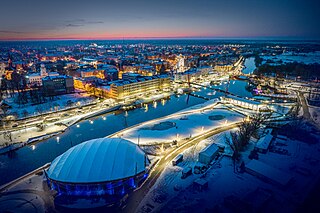
Jelgava is a state city in central Latvia. It is located about 41 kilometres southwest of Riga. It is the largest town in the region of Zemgale (Semigalia). Jelgava was the capital of the united Duchy of Courland and Semigallia (1578–1795) and was the administrative center of the Courland Governorate (1795–1918).

Historical Latvian Lands or formerly Cultural regions of Latvia are several areas within Latvia formally recognised as distinct from the rest of the country. These are: Kurzeme (Courland), Zemgale (Semigallia), Latgale (Latgalia), Vidzeme, and Sēlija (Selonia). While some of these regions are seen purely as culturally distinct, others have historically been parts of different countries and have been used to divide the country for administrative and other purposes.

Semigallia is one of the Historical Latvian Lands located to the south of the Daugava and to the north of the Saule region of Samogitia. The territory is split between Latvia and Lithuania, previously inhabited by the Semigallian Baltic tribe. They are noted for their long resistance (1219–1290) against the German crusaders and Teutonic Knights during the Northern Crusades. Semigallians had close linguistic and cultural ties with Samogitians.

Jelgava District was an administrative division of Latvia, located in Semigallia region, in the country's centre. It was organized into a city, two municipalities and twelve parishes, each with a local government authority. The administrative centre of the district was Jelgava. It preceded and used the symbols of the Jelgavas apriņķis of the interwar Republic of Latvia, which was created in 1920 from the previous Dobeles apriņķis.
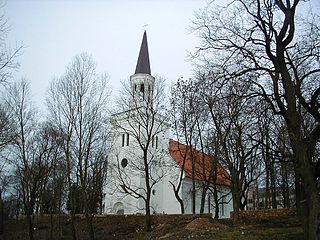
Iecava is a town on the via Baltica in Bauska Municipality, in the Semigallia region of southern Latvia. The town has a population of around 9700 people. Iecava lies 40 km south of Riga and 23 km north of Bauska and was mentioned in historical documents as early as 1492. Until the 2021 Latvian administrative reform took into force on 1 July 2021, Iecava was a village and the center of Iecava Municipality.

Kalnciems is a village in Jelgava Municipality in the Semigallia region of Latvia. Located on the left bank of the Lielupe, 5 km south of the A9 motorway. Distance to Jelgava 24 km, to Riga - 49 km. Because of the dolomite and clay mines - in Kalnciems developed a big building materials industry center next to the Lielupe's waterway and by the end of the 19th century, the finished products were transported to Riga for its new buildings.
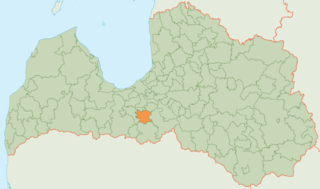
Iecava Municipality is a former municipality in the historical region of Semigallia, and the Zemgale Planning Region in Latvia. The municipality was formed 2003 by a reorganization of Iecava Parish, the administrative centre being Iecava. The municipality consisted of the following settlements: Audrupi, Dimzukalns, Dzelzāmurs, Dzimtmisa, Iecava, Rosme, Vanči, Zālīte, Ziemeļi, Zorģi. The population in 2020 was 8,353.
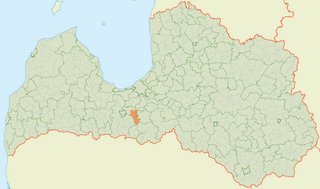
Salgale Parish is an administrative unit of Jelgava Municipality in the Semigallia region of Latvia.
Cena is a small village in Jelgava Municipality in the Semigallia region of Latvia. The village located at Misa River approximately 32 km from the capital Riga and 10 km from the city of Jelgava.

The Misa is a river, 108 kilometres long, in the Semigallia region of Latvia. Its upper course till its tributary Zvirgzde river is rectificated. There are active peat extraction sites and polders on the banks of the river from the village of Stelpe to Beibeži. From the Zvirgzde river to the village of Plakanciems there are several summer cottage colonies on the wooded banks of the Misa. Below Plakanciems to the Misa's confluence with the Iecava near Ozolnieki, the land either side of the river has a relatively high population density.

Dalbe is a village in Cena Parish, Jelgava Municipality in the Semigallia region of Latvia. The village located at Misa river approximately 28 km from the capital Riga and 14 km from the city of Jelgava.

Tetele is a village in Cena Parish, Jelgava Municipality in the Semigallia region of Latvia. The village is located on the Lielupe river approximately 39 km from the capital Riga and 8 km from the city of Jelgava.

Jaunauce Manor is a manor house in Jaunauce parish in Saldus municipality in the historical region of Courland, in western Latvia.

Ozolnieki is a village in Ozolnieki Parish, Jelgava Municipality in the Semigallia region of Latvia. The village is located at Iecava river approximately 36 km (22 mi) from the capital Riga and 6 km (4 mi) from the city of Jelgava.

Emburga is a village in Salgale Parish, Jelgava Municipality in the Semigallia region of Latvia. The village is located at Lielupe river approximately 22 km from the city of Jelgava.

The Iecava is a river in Latvia, in the regions of Selonia and Semigallia. Its source is formed from several springs in Daudzese Parish, Aizkraukle Municipality. Its mouth is located 4 km below the town of Jelgava on the Lielupe river.

Zālīte is a village in Iecava parish, Bauska municipality. It is located in the west of the parish at the inlet of the Īkstruma in Iecava, 9.3 km from the parish center Iecava, 27.9 km from the municipality center Bauska and 54 km from Riga.
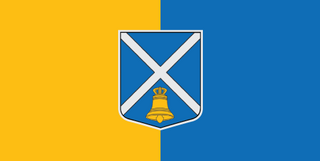
Iecava parish is one of the territorial units of Bauska Municipality in its north. The parish includes the city of Iecava from all sides. It is bordered by Code, Dāviņi, Mežotne, Stelpe and Vecumnieki parishes of its own Municipality, Salgale parish of Jelgava Municipality, Baldone parish of Ķekava Municipality and Olaine parish of Olaine Municipality. From 2003 to 2021, Iecava Municipality was located on its territory.

The Īkstrums, also Ikstrums, is a river in Semigallia, Latvia. It flows through the parishes of Bauska, Code, Mežotne and Iecava, where it flows into the River Iecava as a left-bank tributary. It begins southwest of Code as the former headwaters of the Garoze River. In length it is 23 or 28 km.


































